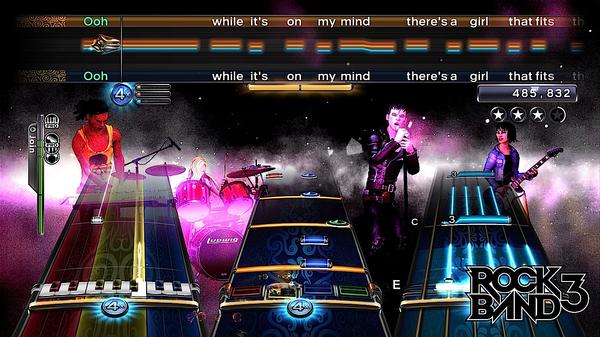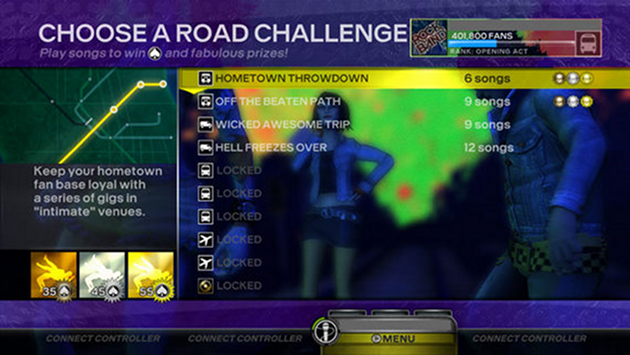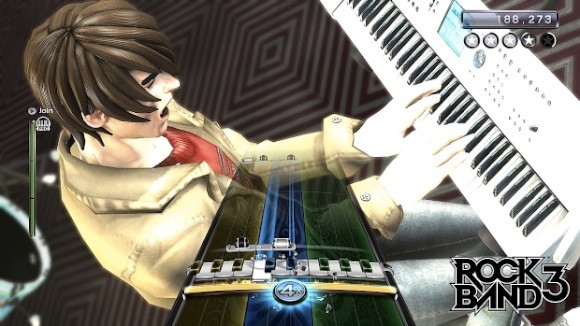It’s fitting that the opening scene of Rock Band 3 plays to The Doors’ "Break On Through (To the Other Side)."
Rock Band 2, for all of its technical improvements and music updates, felt more like an expansion pack to a game that was already building its legacy as more of a platform than game franchise. Rock Band 3, on the other hand, feels more like a true sequel, a game that catapults the franchise towards its rightful position as the king of the music genre. It improves on almost every aspect of the franchise, adding much-needed refinement and tweaking, while also completely evolving the genre, breaking through to the next eventual side in music games: real instruments.
Rock Band 3 does keep its core gameplay intact. You’ll still be tapping your guitar, drums, and now keyboard, to colored gems as they flow down the track. It’s still fun, responsive, and the best at making you feel like you’re playing a real instrument, yet Harmonix has now added a few changes to keep things interesting. The more accurately you play and the more successful you are at building streaks, the more often you’ll make special Overdrive note sections appear. These are noted with a gold glow around the section. Successfully nail these sections and you’ll instantly gain a half bar of Overdrive to deploy.

Of course the biggest additions are the Keyboard controller and Pro Mode. Keys are played using a 25-key instrument that uses five keys to correspond with the five colors during normal play. Playing the keyboard for the first time was great fun and gave me the same feeling as the first time I picked up a plastic guitar. A downside is that quite a few of my library songs do not have keyboard parts, although most of the Rock Band 3 set list includes keyboard parts. Future DLC selections will of course consider this new instrument.
Pro Mode abandons the old note tracks and brings in a new note track that simulates playing a real instrument. I wasn’t able to play Pro Guitar (the peripheral has not released yet), but I tackled Pro Drums and Keyboard, and it’s really a completely new way to play. Pro Drums adds cymbal specific note gems and requires use off all 8 pads to play. Pro Keys uses all 25 keys and displays 10 keys on the track at a time. Different colored queues tell you which part of the instrument you have to play. The harder the difficulty, the greater the range and more keys you have to play. I never felt I was learning anything about the drums, mostly because the Rock Band drums are not an accurate representation of real drums, but learning keys felt like I was learning a real instrument. It remains to be seen how the guitar will fare, but Pro Mode is a challenging and immensely fun way of playing the Rock Band you may be familiar with.
UPDATE: After acquiring the Fender Mustang PRO-Guitar, I can now say that the Pro Guitar trainer is where the magic happens, and this game mode walks you through learning how to play the guitar, teaching notes, power chords, and open chords. The way it works in Rock Band 3 is a number comes down the note highway on a string. So if there is a 5 rolling down on the third string, you will push the 3 string button on the fifth fret, strumming the third string. Same goes for power chords and open chords, though a little more complex. Here, the number you start your index finger on will appear, and a shape will accompany it. As you make the correct finger placement on the guitar frets to play the chord, an outline will appear on the note highway, replicating the shape coming and letting you know if you have the chord right.
If that sounds complex, don’t worry, it is. Playing the guitar is not a walk in the park, but Harmonix is determined to help you along the way. The trainer is split up into basic, intermediate, and advanced lessons, teaching you finger placement and chords. They will have you playing common melodies and exercises to get you into shape, which you can slow down and repeat as you like in order to learn it all. If you miss any note or chord, the trainer stops, shows you the neck of a guitar and where your fingers should be placed, and highlights which strings you need to strum once you have those buttons pressed. This trainer also bleeds into any Pro-enabled songs you have. You can bring any song into the trainer and the trainer breaks it into sections to teach you the specific chords and progression.
What the trainer won’t do, though, and this is only for people looking to be serious about playing an instrument, is teach you theory. You won’t learn about chords, why you would use them, or their purpose. It won’t teach you the how or why of music, which is understandable. Music theory is usually reserved for college majors. You can learn how to play The Doors "Break on through to the Other Side" in its entirety, but you won’t understand what you are playing at a technical level. What the trainer does well, though, is teach you the basics, get you familiar with the guitar, and if you enjoy what you learn, release you into the world to seek more advanced help.
Aside from new instruments and note track changes, Harmonix has overhauled Rock Band 3‘s interface and Career progression. Now, every player has their own personal menu. While one player may be navigating to find your next song, you can push Start on your instrument and change your settings without making everyone else wait. Changing your track to No-Fail Mode, switching to Lefty Flip, or even changing your difficulty mid-song is all possible and each player can do it simultaneously. Players can drop in and out at the touch of a button as well, and it’s all effortless and easy. It’s so well done that you will wonder why this hasn’t been present from the start. The game handles it all very well, even rewinding the song a few seconds when you resume so you won’t make mistakes.

Career progression has also been reworked completely and now works better than it ever has before. Instead of playing through World Tour and endless set lists of songs you just don’t want to play, Career is handled by a set of in-game goals. These goals will have you play songs a certain way, such as getting so many stars on a song or playing a solo using only the tiny buttons on the guitar. As you complete the goals, you’ll gain fans which get you closer to your next career milestone, like getting a van or becoming an opening act. You can easily track what goals you haven’t completed, and selecting one immediately sets you up with the conditions you need or songs you have to play to complete it. With this new system, you don’t have to play songs you don’t like over and over again in different set lists to progress. You can complete the goals the way you decide and, even importing songs from say, Rock Band or the AC/DC track pack, create custom goals as well. You’ll always have an option, so how you play Rock Band 3 is entirely up to you.
The closest you’ll get to a World Tour mode is the collection of Road Challenges, which are sequenced challenges that require you and your band to play different gigs locally or across the country, completing gig-specific objectives. These tasks consist of deploying Overdrive as many times as possible, playing the song as accurately as you can, or building a streak that you then pass off to another bandmate who has to keep the streak alive before passing it on to yet another player. It’s an interesting way to change the way you play songs and keep things fresh for you. This mode also offers pre-arranged set lists to play, but again, if you don’t like the songs, you can choose a random set list or a custom set list.
I’ve been mentioning a lot of band-specific fun, and if you don’t have friends who live close or at least enough to fill out all the instruments, you can rely on the game’s full online play. Every mode can be played online who other players, filling in your empty spots with online buddies. There are also set list Battles you can participate in and custom playlists you can create and share with your friends list for high score bragging rights.

Visually, Rock Band 3 looks leaps and bounds better than its predecessors. The character models have been updated and look less like plastic dolls and more like the exaggerated rock personas that they were originally envisioned as. The facial expressions are great as the characters sing, and their movements are much more fluid as they play their instruments. Performances are better choreographed to the music, with certain special effects occurring during different songs, such as an 80s stop-motion effect during The Cure’s "Just Like Heaven" or a psychedelic light show to the Flaming Lips’ "Yoshimi Battles the Pink Robots Pt.1."
Music selection is always a subjective issue with rhythm games, so your enjoyment of the tracks will be based on your tastes. For me, the game has the best track list out of all three main games. Echo and the Bunneymen, The Cure, The Flaming Lips, The Doors, and The Smiths are all some of my favorite bands and are featured here. There is something for everyone on the list, though, so no matter what you’re into, Rock Band 3 has a large cross section of choices here. Nearly all of these tracks have been big hits, and that’s perhaps the best measure of the soundtrack’s quality and overall appeal. The online store is available, too, if you want to build a more personal list of favorites, but the songs on the disc are amazing even if you don’t hit the music store.
Rock Band 3 is a complete package and quite possibly the definitive music game. Once again, Harmonix defines and sets the bar for what the music genre can achieve. It will be hard pressed for anyone, Harmonix included, to top this game. But until then, it’s an incredibly fun, rocking good time.


















